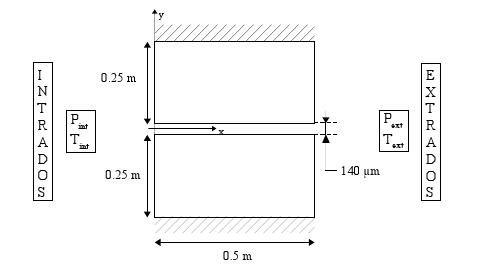1. Reference problem#
This test is inspired by test SIMIBE carried out at CEA.
Three different models are described. The material and flow characteristics are the same for all three models, and they are described in section §1. The geometry changes slightly for all three models. A diagram of the geometry for modeling A is shown in §1.1; for the other models, the differences will be described.
1.1. Geometry and material#
The overall geometry is shown on the. The characteristics of the crack are given at the bottom. Note that the units are expressed in the international S.I. system. As also specified in the U7.03.41 user documentation, this is made mandatory by the Crayvisse software, which contains non-dimensionalized formulas.

Figure 1.1-a : geometry of the test case
Details of the crack:
section: RECTANGLE
flow direction: \(X\), in the positive direction
absolute wall roughness: \(\mathrm{0,5}{.10}^{-6}m\)
singular pressure loss coefficient at the inlet: none (ZETA = 0)
dimension of the crack in the direction normal to the plane (\(z\)): \(0.5m\) (LIST_VAL_BL = (0.5,0.5))
remanent opening fixed to \(30\mu m\)
Flow:
inlet stagnation pressure: \({10.10}^{5}\mathrm{Pa}\)
stagnation pressure at the outlet: \({10}^{5}\mathrm{Pa}\)
condition of the inlet fluid: air only (FLUIDE_ENTREE = 6)
inlet temperature: \(140°C\)
Model:
flow pattern at SATURATION
friction calculated directly from the absolute roughness of the wall (FROTTEMENT = 1)
heat transfer with a Sieder & Tate correlation in laminar monophasic and a Mac Adams correlation in the other regimes. In the case of a gas/liquid mixture, calculation either in the gas, or in the liquid, or via the Chen correlation as a function of the gas mass titer and the void ratio (TRANSFERT_CHAL = 1).
1.2. Material properties#
The values chosen are representative of concrete.
\(E=35000\mathrm{MPa}\)
\(\nu =0.25\)
\(\alpha =10-5/°C\)
\(\lambda =2.3J/{m}^{2}s°C/m\)
\(\rho {C}_{p}=2500000J/{m}^{3}°C\)
1.3. Boundary conditions and loading#
The upper and lower parts are embedded.
It is assumed that the crack cannot be completely closed. Thus, the residual opening is fixed at \(30\mu m\) to leave a non-zero minimum fluid flow.
Extrados, the temperature is always \({T}_{\mathrm{ext}}=20°C\) and the pressure \({P}_{\mathrm{ext}}=1.105\mathrm{Pa}\).
On the internal and external sides, it is assumed that exchanges with the ambient environment take place with the following exchange coefficients: \({h}_{\text{int}}=\mathrm{8W}/{m}^{2}\) and \({h}_{\mathit{ext}}\mathrm{=}\mathrm{4W}\mathrm{/}{m}^{2}\)
Hot air is injected under pressure, i.e. \({T}_{\text{int}}\mathrm{=}140°C\) and \({P}_{\text{int}}\mathrm{=}{10.10}^{5}\mathit{Pa}\).
1.4. Initial conditions#
The concrete is at rest, at \(20°C\), with a \(140\mu m\) through crack.